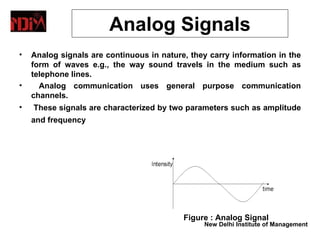
Unit2(Cont.)
- 1. Data Representation Analog Signals • Analog signals are continuous in nature, they carry information in the form of waves e.g., the way sound travels in the medium such as telephone lines. • Analog communication uses general purpose communication channels. • These signals are characterized by two parameters such as amplitude and frequency Figure : Analog Signal New Delhi Institute of Management
- 2. Data Digital Signals Representation • Digital signals are discrete in nature. • They transfer information in the form of 0s and 1s. • In digital communication, data are transmitted directly in binary form that is a sequence of 0s and 1s. To transmit binary data over these channels 0s and 1s should be converted to the electrical signals. This is done by Modem (modulator-demodulator). • Digital signals are preferred over analog signals. Because of the discrete nature, these signals are not affected by noise or any other disturbances. New Delhi Institute of Management
- 3. Data Representation Digital Signals Cont… Figure : Digital Signal New Delhi Institute of Management
- 4. Data Representation Bandwidth • Bandwidth is the frequency range of a channel, measured as the difference between the highest and lowest frequencies that the channel supports. • Bandwidth is the capacity for a given system to transfer data over a connection. It is measured as a bit rate expressed in bits/s or multiples of it (kb/s Mb/s etc.). • The maximum transmission speed depends upon the available bandwidth. • The larger the bandwidth, the higher the transmission speed. • A normal voice channel has a bandwidth of 3.1 KHz. In real life scenario, it is equivalent to about 1200 bps max. for a binary digital signal. New Delhi Institute of Management
- 5. Data Representation Applications of Networking • Resource Access: Regardless of the physical location of the resources and the users, networks can provide special computing resources with convenient access at any time to its users. These resources sharing may be of specialized computers, software or other devices that are expensive or unique. For example accessing a corporate supercomputer from workstations at remote research laboratories New Delhi Institute of Management
- 6. Data Representation Applications of Networking cont…… • Data Access: Networks can provide access to unique database to its local and remote users. • Communication and Data Exchange: Networks allow users to exchange data, graphs or documents and to communicate using email, bulletin boards or by teleconference, irrespective of the time or their location. 4. Decentralization of Data Processing: A complicated job can be divided into multiple modules and can be distributed to different departments for processing. New Delhi Institute of Management
- 7. Data Representation Applications of Networking cont…… 5. Easy Communication: Various organizations cooperating in a task can communicate with each other on network and exchange information. New Delhi Institute of Management
